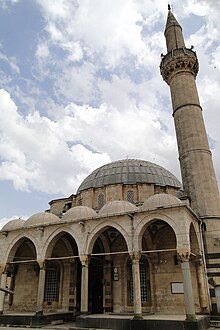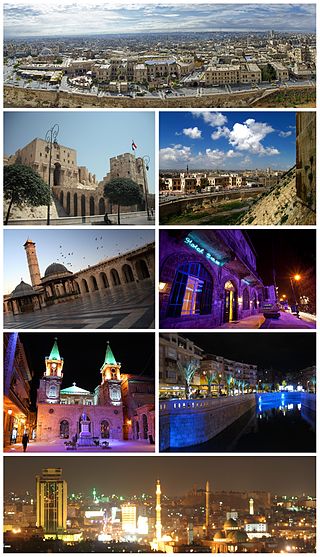
Aleppo is a city in Syria, which serves as the capital of the Aleppo Governorate, the most populous governorate of Syria. With an estimated population of 2,098,000 residents as of 2021, it was Syria's largest city until its population was surpassed by Damascus, the largest in Syria's northern governorates and also one of the largest cities in the Levant region.

Mimar Sinan also known as Koca Mi'mâr Sinân Âğâ, was the chief Ottoman architect, engineer and mathematician for sultans Suleiman the Magnificent, Selim II and Murad III. He was responsible for the construction of more than 300 major structures, including the Selimiye Mosque in Edirne, the Kanuni Sultan Suleiman Bridge in Büyükçekmece, and the Mehmed Paša Sokolović Bridge in Višegrad, as well as other more modest projects such as madrasa's, külliyes, and bridges. His apprentices would later design the Sultan Ahmed Mosque in Istanbul and the Stari Most bridge in Mostar.
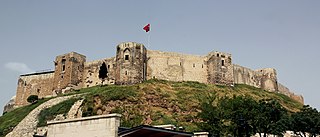
Gaziantep, historically Aintab and still informally calledAntep, is a major city in south-central Turkey. It is the capital of the Gaziantep Province, in the westernmost part of Turkey's Southeastern Anatolia Region and partially in the Mediterranean Region. It is located approximately 185 km (115 mi) east of Adana and 97 km (60 mi) north of Aleppo, Syria and situated on the Sajur River. The city is thought to be located on the site of ancient Antiochia ad Taurum and is near ancient Zeugma.

Bilecik Province is a province in midwest Turkey, neighboring Bursa to the west, Kocaeli and Sakarya to the north, Bolu to the east, Eskişehir to the southeast and Kütahya to the south. Its area is 4,179 km2, and its population is 228,673 (2022). Most of the province laid down in Marmara Region but eastern parts of Gölpazarı and Söğüt district and districts of İnhisar and Yenipazar remained in Black Sea Region, smaller southeastern parts of Bozüyük and Söğüt remained in Central Anatolia Region and smaller southwestern part of Bozüyük remained in Aegean Region.

Mardin is a city and seat of the Artuklu District of Mardin Province in Turkey. It is known for the Artuqid architecture of its old city, and for its strategic location on a rocky hill near the Tigris River.

Bor is a town in Niğde Province in the Central Anatolia region of Turkey, 14 km (8.7 mi) to the southeast of the city of Niğde, on a high plain. It is the seat of Bor District. Its population is 41,999 (2022).
The Armenians in Syria are Syrian citizens of either full or partial Armenian descent.

Aleppo Governorate is one of the fourteen governorates of Syria. It is the most populous governorate in Syria with a population of more than 4,867,000, almost 23% of the total population of Syria. The governorate is the fifth in area with an area of 18,482 km2 (7,136 sq mi), or 18,498 km2, about 10% of the total area of Syria. The capital is the city of Aleppo.

İznik is a municipality and district of Bursa Province, Turkey. Its area is 753 km2, and its population is 44,236 (2022). The town is at the site of the ancient Greek city of Nicaea, from which the modern name derives. The town lies in a fertile basin at the eastern end of Lake İznik, with ranges of hills to the north and south. As the crow flies, the town is only 90 kilometres southeast of Istanbul but by road it is 200 km around the Gulf of İzmit. It is 80 km by road from Bursa.
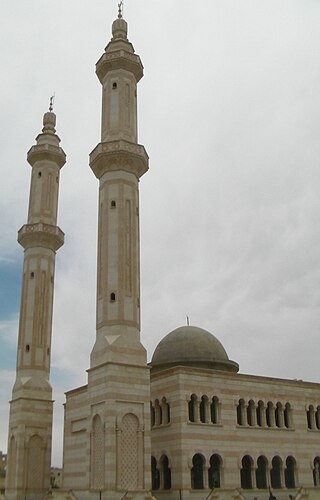
Azaz is a city in northwest Syria, roughly 20 miles north-northwest of Aleppo. According to the Syria Central Bureau of Statistics (CBS), Azaz had a population of 31,623 in the 2004 census. As of 2015, its inhabitants were almost entirely Sunni Muslims, mostly Arabs but also some Kurds and Turkmen.

The Vilayet of Aleppo was a first-level administrative division (vilayet) of the Ottoman Empire, centered on the city of Aleppo.
Öncüpınar, historically Tibil, is a neighbourhood of the city Kilis, Kilis District, Kilis Province, Turkey. It lies south of the city of Kilis, and north of the Syrian town of Azaz. The village had a population of 1,333 in 2022.
Aydoğan Fuat, formally referred to as Shaykh Abdul Kerim al-Qubrusi, was an American Sufi Sheikh of Turkish Cypriot origin and former representative of the Naqshbandi-Haqqani Order in the United States, under the leader Nazim Al-Haqqani.

Rabia Bala Hatun was the wife of Osman I, the founder of the Ottoman Dynasty. She was the daughter of Sheikh Edebali and the mother of Alaeddin Ali Pasha of the Ottoman Empire.
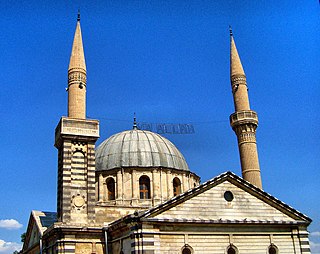
Liberation Mosque, formerly the St. Mary's Cathedral or Holy Mother of God Church, is located in the Tepebaşı district of Şahinbey, Gaziantep in Turkey. Initially built as an Armenian Apostolic church, it was converted into a stable after the Armenian genocide; and later, into a jail. Sarkis Balyan—the Ottoman-Armenian architect serving Sultan Abdul Hamid II—designed the church. The building was constructed between 1892 and 1893, undertaken by the stonemason Sarkis Taşçıyan. The church was part of a complex which also contained a school and the administrative buildings of the dioceses of the kaza of Antep.
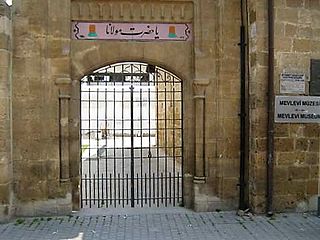
Mevlevi Tekke Museum is a tekke in Nicosia, Cyprus, currently in North Nicosia. It has historically been used by the Mevlevi Order and now serves as a museum. It is one of the most important historical and religious buildings on the island. It is located next to the Kyrenia Gate, on Girne Avenue, in the İbrahimpaşa quarter.

The Sultan Murad Division is an armed rebel group in the Syrian Civil War, created around a Syrian Turkmen identity. It is aligned with the Syrian opposition and are heavily supported by Turkey, who provides funding and military training along with artillery and aerial support. It is the most notable group among Syrian Turkmen Brigades supported by Turkey.

Al-Kindi Ensemble is a Sufi musical group founded in 1983 by Julien Jalâl Eddine Weiss. Based in Aleppo, Syria, Al Kindi Ensemble is mostly known for its works on the Arab-Muslim and Sufi musical traditions.
Barak, commonly referred to as Barak Turkmens, is a Turkoman tribe that mainly originates in the Barak Plain in the southeastern portion of the province of Gaziantep in south-central Turkey.
Elbegli is a Turkoman tribe mainly residing in Kilis, Gaziantep, and Sivas provinces in Turkey.


